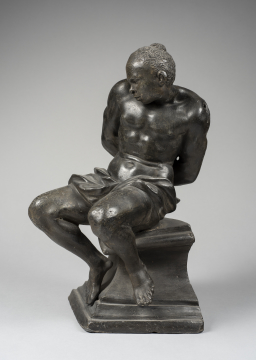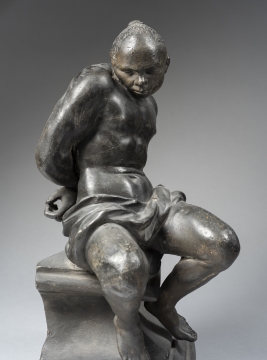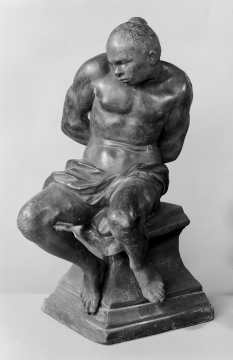Explore Collections


You are here:
CollectionsOnline
/
A captive after one of Pietro Tacca's figures on the monument to Ferdinand I de' Medici in Livorno (Leghorn), Italy.
Browse
SM MY40. ©Sir John Soane's Museum, London. Photo: Art UK
A captive after one of Pietro Tacca's figures on the monument to Ferdinand I de' Medici in Livorno (Leghorn), Italy.
Lead
Museum number: MY40
Not on display
Curatorial note
This figure is based on one of the four figures by Tacca, representing captured Ottoman pirates (1620–24) and intended to celebrate various sea victories against them, around the base of Giovanni Bandini's statue of Ferdinando I de' Medici, Grand Duke of Tuscany, in Piazza Micheli, Livorno. The figures are often referred to as the Quattri Mori ('four Moors') and were regarded as Tacca's masterpieces. The figure of Ferdinando came first in 1595-99 and the four captive figures followed in the first half of the 1620s. Tacca is said to have made studies from life of Turkish and Algerian men held in the Bagno dei Forzati in Livorno and used by the Duke as galley slaves - it is thought that three of the figures are Turkish and the fourth a black African. All are chained and whilst some contemporaries praised the artistic qualities of Tacca's figures many regarded the monument as a repulsive glorification of slavery, including Napoleon's General Sextius Miollis who wrote to the Commune of Livorno describing the bound slaves as a 'distressing spectacle' which 'insults humanity'. Steven Ostrow has described them 'struggling against their captivity, with expressions of pain, sorrow, and hopelessness'.
Reduced-scale bronze adaptations were made by another sculptor employed by the Medici, Foggini, which provided the source for the many reproductions made for sculpture connoisseurs into the 18th century. Ceramic versions were made by Doccia (there is an example in the Soane collection SM M214) and other manufacturers.
This figure seems to be loosely based on the northeast corner figure on the monument (see Ostrow, 2015, figs.8 and 14). It is one of a pair of lead figures after the Tacca captives which were displayed outside by Soane on the window-sill of his Dressing Room, overlooking the Monk's Yard. It is possible that these two may have been designed to be displayed outside as garden ornaments, being lead rather than bronze.
By his ownership and display of no less than three figures depicting chained captives after the Livorno monument Soane may have been signalling support for the emancipation of slaves, although this is not certain and these figures represent men enslaved during anti-piracy actions in the Mediterranean rather than by the transatlantic slave trade. However, he also owned a group of slave shackles which he displayed to draw attention to man's inhumanity to man and it is possible that he perceived a link between these two groups of objects.
Reduced-scale bronze adaptations were made by another sculptor employed by the Medici, Foggini, which provided the source for the many reproductions made for sculpture connoisseurs into the 18th century. Ceramic versions were made by Doccia (there is an example in the Soane collection SM M214) and other manufacturers.
This figure seems to be loosely based on the northeast corner figure on the monument (see Ostrow, 2015, figs.8 and 14). It is one of a pair of lead figures after the Tacca captives which were displayed outside by Soane on the window-sill of his Dressing Room, overlooking the Monk's Yard. It is possible that these two may have been designed to be displayed outside as garden ornaments, being lead rather than bronze.
By his ownership and display of no less than three figures depicting chained captives after the Livorno monument Soane may have been signalling support for the emancipation of slaves, although this is not certain and these figures represent men enslaved during anti-piracy actions in the Mediterranean rather than by the transatlantic slave trade. However, he also owned a group of slave shackles which he displayed to draw attention to man's inhumanity to man and it is possible that he perceived a link between these two groups of objects.
Unknown but in Soane's collection by 1825 when it appears, with its pair, in a watercolour depicting the view out of the Dressing Room window.
Literature
Anthea Brook, 'From Borgo Pinti to Doccia: The Afterlife of Pietro Tacca’s Moors for Livorno' in The Slave in European Art From Renaissance Trophy to Abolitionist Emblem edited by Elizabeth McGrath and Jean Michel Massing (Warburg Institute Colloquia, 20 Editors: Jill Kraye and Charles Burnett), The Warburg Institute – Nino Aragno Editore, London and Turin, 2012.
For further reading on the Livorno monument and the Tacca slaves see: John Pope-Hennessey, Italian Sculpture, Volume 3; Steven F. Ostrow, 'Pietro Tacca's "Quattri Mori": Legend as fact' in Arte e Politica: Studi per Antonio Pinelli, Florence, 2013 pp.87-90; and Steven F. Ostrow, 'Pietro Tacca and his Quattro Mori: The Beauty and Identity of the Slaves', Artibus et Historiae XXXVI 71, 2015, pp.145-180.
For further reading on the Livorno monument and the Tacca slaves see: John Pope-Hennessey, Italian Sculpture, Volume 3; Steven F. Ostrow, 'Pietro Tacca's "Quattri Mori": Legend as fact' in Arte e Politica: Studi per Antonio Pinelli, Florence, 2013 pp.87-90; and Steven F. Ostrow, 'Pietro Tacca and his Quattro Mori: The Beauty and Identity of the Slaves', Artibus et Historiae XXXVI 71, 2015, pp.145-180.
Associated items
Soane collections online is being continually updated. If you wish to find out more or if you have any further information about this object please contact us: worksofart@soane.org.uk



















